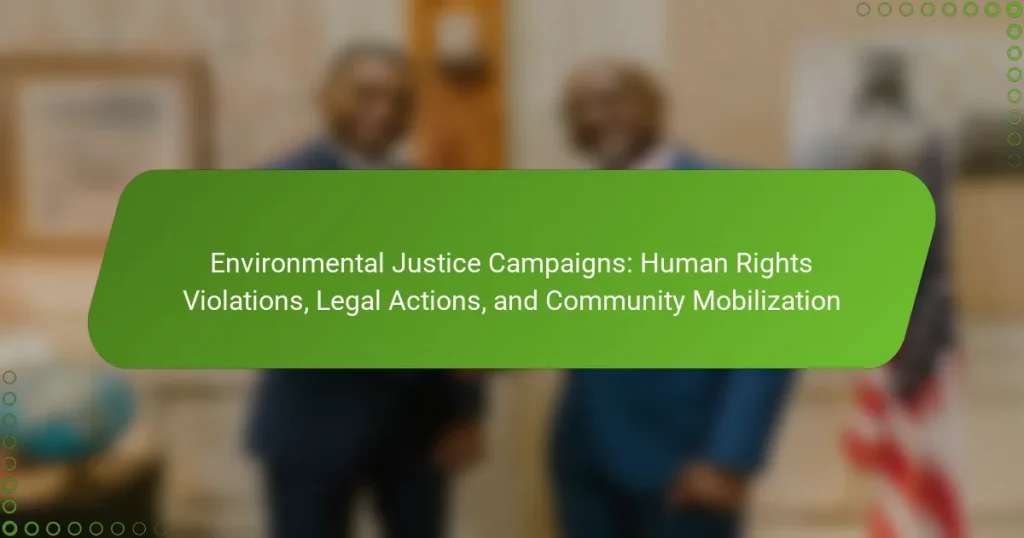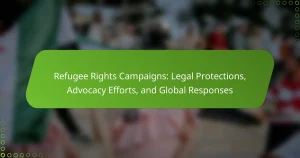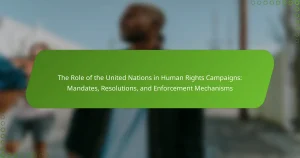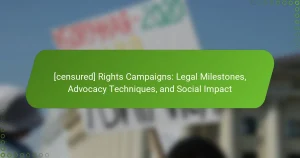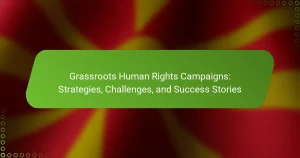Environmental Justice Campaigns are organized efforts that address environmental inequalities affecting marginalized communities. These campaigns focus on the disproportionate impact of environmental hazards, such as pollution and inadequate waste management, on vulnerable populations. Grassroots mobilization and advocacy are central to these initiatives, which often involve legal actions to protect community rights and push for equitable regulations. The article explores the historical context of these campaigns, their role in highlighting health disparities, and the significant influence of grassroots movements in driving policy changes to ensure all communities have access to a healthy environment.
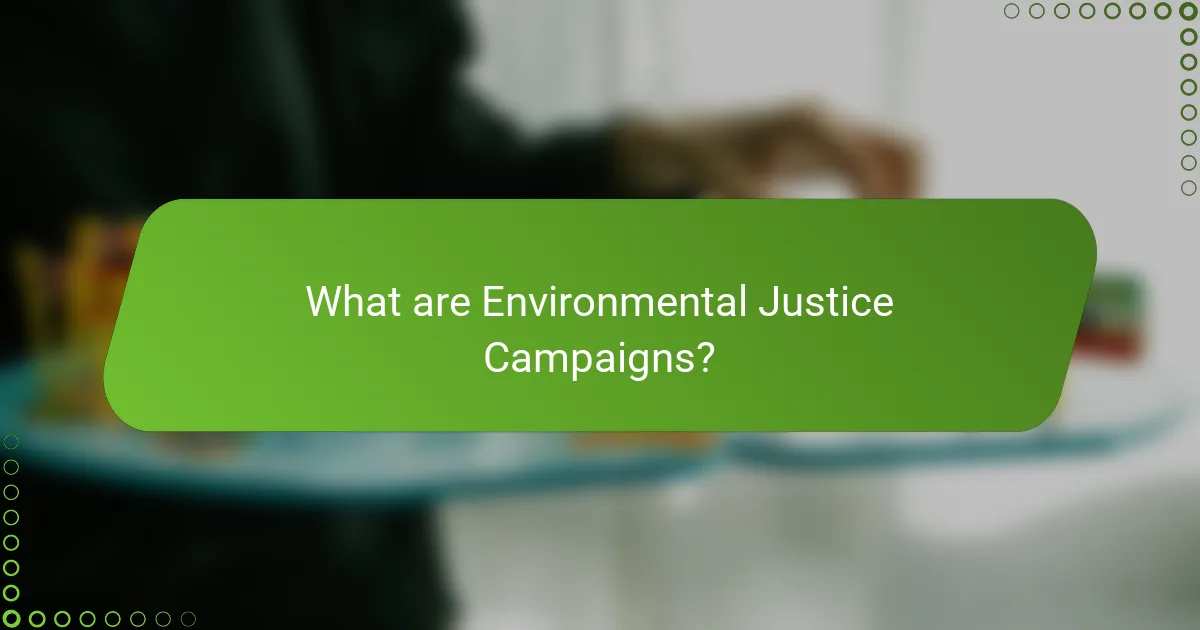
What are Environmental Justice Campaigns?
Environmental Justice Campaigns are organized efforts aimed at addressing environmental inequalities. These campaigns focus on the disproportionate impact of environmental hazards on marginalized communities. They seek to ensure that all communities have equal access to a healthy environment. Environmental Justice Campaigns often involve grassroots mobilization and advocacy. They highlight issues such as pollution, waste management, and resource access. Campaigns may also engage in legal actions to protect community rights. Historical examples include the fight against toxic waste sites in low-income neighborhoods. These efforts are rooted in the belief that environmental rights are human rights.
How do Environmental Justice Campaigns address human rights violations?
Environmental justice campaigns address human rights violations by advocating for marginalized communities affected by environmental degradation. These campaigns emphasize the right to a healthy environment, linking it to broader human rights issues. They often highlight cases where pollution and resource exploitation disproportionately impact low-income and minority populations. For instance, the Flint water crisis exemplifies how systemic neglect can violate basic human rights. Environmental justice organizations mobilize communities to demand accountability and legal action against corporations and governments. They utilize legal frameworks to challenge policies that perpetuate environmental harm. By raising awareness, these campaigns empower communities to voice their concerns and seek justice. This approach fosters a holistic understanding of environmental issues as interconnected with social justice and human rights.
What types of human rights violations are commonly linked to environmental issues?
Human rights violations commonly linked to environmental issues include the right to health, the right to clean water, and the right to a safe environment. These violations often occur due to pollution and environmental degradation. For instance, communities near industrial sites frequently suffer from health problems due to toxic emissions. Access to clean water is compromised in areas affected by contamination from mining or agricultural runoff. Furthermore, indigenous peoples often face displacement as their lands are exploited for natural resources. This leads to violations of their rights to land and cultural heritage. Reports from organizations like Human Rights Watch provide evidence of these links.
How do these violations impact marginalized communities?
Human rights violations significantly impact marginalized communities by exacerbating existing inequalities. These communities often face increased exposure to environmental hazards. For example, studies show that low-income neighborhoods are more likely to be located near toxic waste sites. This proximity leads to higher rates of health issues, such as respiratory diseases and cancer. Additionally, marginalized groups frequently lack access to legal recourse. This limits their ability to challenge harmful practices and seek justice. Furthermore, violations erode community trust in governing bodies. This distrust can hinder effective mobilization for change. Overall, the compounded effects of these violations deepen social, economic, and environmental disparities.
What role do legal actions play in Environmental Justice Campaigns?
Legal actions serve as a critical tool in Environmental Justice Campaigns. They provide a mechanism for marginalized communities to challenge environmental injustices. Legal actions can include lawsuits against corporations or government entities that violate environmental laws. These lawsuits often aim to hold these entities accountable for pollution or harmful practices.
Moreover, legal actions can lead to significant changes in policy and regulation. Successful cases may result in stricter environmental protections or remediation efforts. For instance, the landmark case of Massachusetts v. EPA established the authority to regulate greenhouse gases. This case exemplifies how legal actions can influence national environmental policy.
Additionally, legal actions can empower communities by raising awareness about their rights. They can mobilize public support and bring attention to local environmental issues. Legal victories often inspire further advocacy and community engagement. Overall, legal actions are essential for advancing environmental justice and protecting vulnerable populations.
What are the common legal frameworks used in these campaigns?
Common legal frameworks used in environmental justice campaigns include international human rights law, national environmental laws, and local ordinances. International human rights law provides a basis for claiming rights to a healthy environment. National environmental laws often include regulations that protect community health and the environment. Local ordinances can empower communities to address specific environmental issues. These frameworks facilitate legal actions against violations related to pollution and land use. For instance, the Clean Air Act and Clean Water Act in the U.S. are frequently cited in these campaigns. These laws support community mobilization efforts to hold corporations accountable for environmental harm.
How effective are legal actions in achieving environmental justice?
Legal actions are effective in achieving environmental justice, but their success varies by case. Courts can enforce environmental regulations and hold violators accountable. For instance, the landmark case of Massachusetts v. EPA in 2007 established the federal government’s obligation to regulate greenhouse gases. Legal actions can also empower marginalized communities by providing a platform to voice grievances. A study by the University of California, Berkeley, found that litigation led to increased environmental protections in low-income areas. However, legal actions can be costly and time-consuming, which may deter some communities. Overall, while not a guaranteed solution, legal actions remain a crucial tool in the pursuit of environmental justice.
How do communities mobilize for Environmental Justice?
Communities mobilize for Environmental Justice through grassroots organizing, advocacy, and coalition-building. They often identify local environmental issues impacting health and well-being. Community members engage in awareness campaigns to educate others about these issues. They utilize social media to amplify their messages and reach a broader audience. Many communities form coalitions with local organizations and environmental groups to strengthen their efforts. They may also participate in public meetings to voice their concerns to policymakers. Legal actions, such as lawsuits, are sometimes pursued to challenge harmful practices. Data shows that organized communities can influence policy changes and achieve significant environmental improvements.
What strategies do communities use to organize and advocate?
Communities use various strategies to organize and advocate for environmental justice. These strategies include grassroots mobilization, coalition building, and public awareness campaigns. Grassroots mobilization involves community members actively participating in advocacy efforts. This can include organizing protests, meetings, and community forums to discuss issues. Coalition building brings together different organizations and groups to strengthen advocacy efforts. Public awareness campaigns aim to educate the broader community about environmental injustices. They often use social media, flyers, and community events to spread their message. Legal actions are also a crucial strategy, where communities file lawsuits to challenge harmful practices. These strategies collectively empower communities to voice their concerns and seek change.
What role do grassroots movements play in these campaigns?
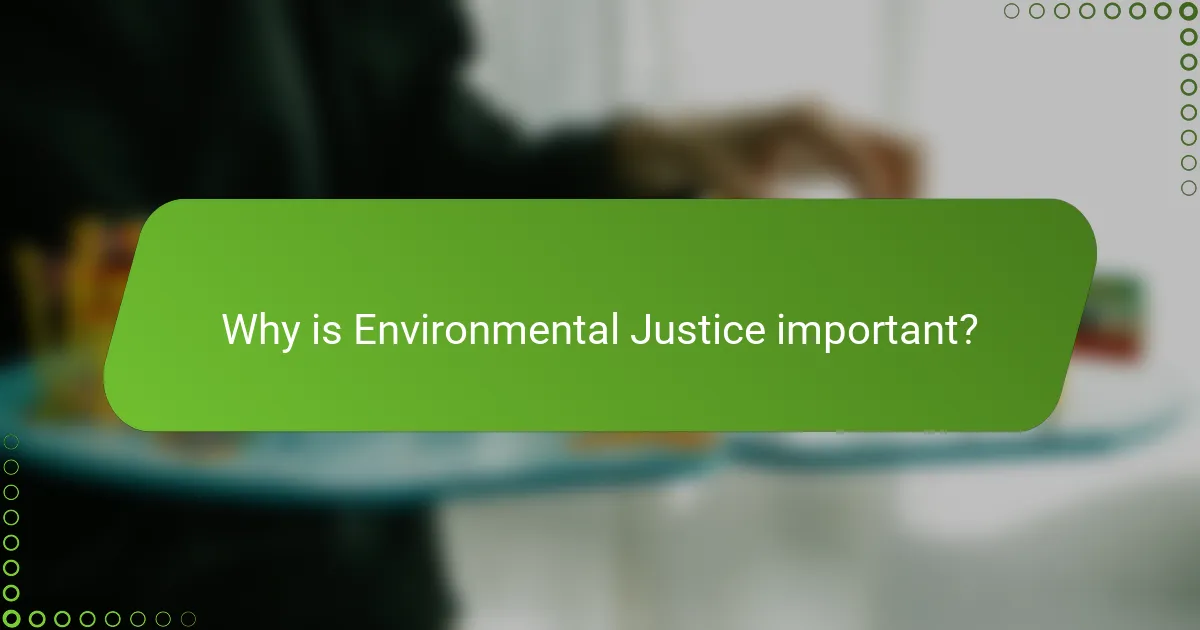
Why is Environmental Justice important?
Grassroots movements play a crucial role in environmental justice campaigns. They mobilize local communities to advocate for their rights and raise awareness about environmental issues. These movements often highlight the disproportionate impact of environmental hazards on marginalized populations. They provide a platform for affected individuals to voice their concerns and demand change. Grassroots organizations frequently collaborate with legal experts to challenge injustices through litigation. They also influence policy by engaging with local governments and advocating for equitable regulations. Research shows that grassroots activism can lead to significant policy changes and increased public awareness. For example, the Environmental Justice Movement in the United States has successfully pushed for stronger regulations to protect vulnerable communities.
What are the social implications of Environmental Justice?
Environmental justice addresses the fair distribution of environmental benefits and burdens among all communities. It seeks to rectify the disproportionate impact of environmental hazards on marginalized groups. Social implications include increased community activism and awareness of environmental issues. Communities often mobilize to demand policy changes and accountability from corporations and governments. This activism can lead to legal actions aimed at enforcing environmental regulations. Moreover, environmental justice initiatives promote health equity by reducing exposure to pollutants. They also foster social cohesion as communities unite for common goals. Ultimately, these efforts contribute to a more equitable society.
How does Environmental Justice contribute to social equity?
Environmental Justice contributes to social equity by ensuring that all communities, particularly marginalized ones, have equal access to a healthy environment. It addresses the disproportionate impact of environmental hazards on low-income and minority populations. By advocating for fair distribution of environmental benefits and burdens, it promotes inclusivity in decision-making processes. Studies show that communities engaged in Environmental Justice campaigns experience improved health outcomes and enhanced quality of life. For instance, the U.S. Environmental Protection Agency highlights that Environmental Justice initiatives lead to better environmental policies that protect vulnerable populations. This alignment of environmental protections with social equity goals fosters a more just society.
What are the long-term benefits of achieving Environmental Justice?
Achieving Environmental Justice leads to improved public health outcomes. Communities benefit from reduced exposure to pollutants and hazardous waste. This results in lower rates of respiratory diseases and other health issues. Economic benefits also arise from increased property values in cleaner environments. Sustainable practices fostered by Environmental Justice can lead to job creation in green industries. Enhanced community engagement strengthens social cohesion and resilience. Access to clean resources promotes equity and reduces disparities. Long-term environmental sustainability is achieved through equitable resource management.
What environmental issues are most commonly associated with justice campaigns?
Environmental issues commonly associated with justice campaigns include climate change, pollution, and deforestation. Climate change disproportionately affects marginalized communities, leading to advocacy for equitable policies. Pollution from industrial activities often harms low-income neighborhoods, prompting legal actions for environmental remediation. Deforestation impacts indigenous lands, fueling campaigns for land rights and sustainable practices. These issues highlight the intersection of environmental degradation and social justice.
How do pollution and resource extraction relate to Environmental Justice?
Pollution and resource extraction are critical issues in the realm of Environmental Justice. Environmental Justice seeks to address the disproportionate impact of environmental hazards on marginalized communities. Resource extraction often leads to pollution, which can harm air, water, and soil quality. Communities near extraction sites frequently suffer from health problems due to exposure to toxic substances. For example, the extraction of fossil fuels has been linked to increased respiratory issues in nearby populations. Additionally, marginalized groups often lack the political power to oppose harmful projects. This inequity highlights the need for fair treatment and meaningful involvement in environmental decision-making. The relationship between pollution, resource extraction, and Environmental Justice is evident in the struggles of communities fighting for their rights and health.
What are the health impacts of environmental injustices?
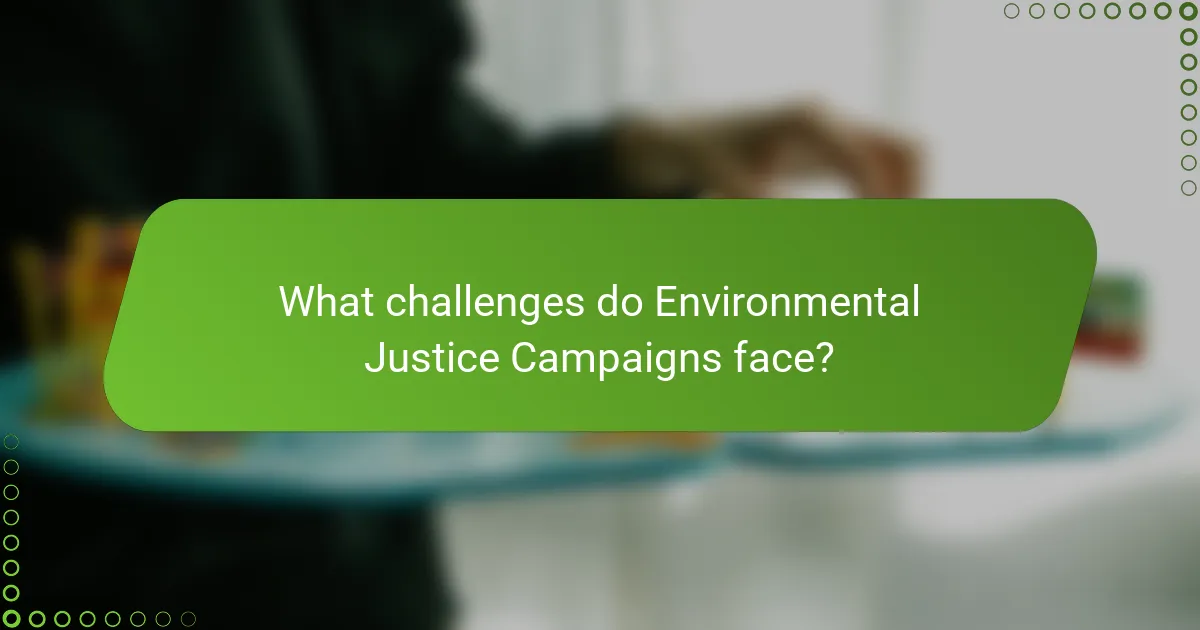
What challenges do Environmental Justice Campaigns face?
Environmental injustices lead to significant health impacts, particularly among marginalized communities. These populations often experience higher exposure to pollutants, resulting in increased rates of respiratory diseases and other health issues. Studies indicate that low-income and minority groups face a greater risk of chronic illnesses due to environmental hazards. For example, the U.S. Environmental Protection Agency reports that communities near industrial sites have elevated levels of lead and other toxins. Additionally, mental health issues can arise from the stress of living in polluted environments. Access to healthcare is also limited in these areas, exacerbating health disparities.
What obstacles do communities encounter in their fight for justice?
Communities encounter various obstacles in their fight for justice. One major obstacle is lack of resources. Many communities do not have sufficient funding for legal representation. This limits their ability to challenge injustices effectively. Additionally, there is often a lack of access to information. Communities may not be aware of their rights or available legal avenues.
Another significant barrier is systemic discrimination. Marginalized communities frequently face biases in the legal system. This can result in unfair treatment and outcomes. Furthermore, there is often limited political support. Decision-makers may prioritize economic interests over community welfare.
Communities also face challenges in mobilization. Organizing collective action can be difficult due to differing priorities. Internal divisions may weaken their efforts. Lastly, there can be intimidation from powerful entities. This can discourage individuals from speaking out or participating in advocacy.
How do political and economic factors hinder progress?
Political and economic factors hinder progress by creating barriers to equitable resource distribution and decision-making. Political instability often leads to inconsistent policies that fail to address environmental justice. Economic constraints limit funding for community initiatives and legal actions. Furthermore, powerful corporate interests can influence political agendas, prioritizing profit over community welfare. Historical examples show that marginalized communities often lack representation in political processes, resulting in inadequate responses to environmental issues. According to the United Nations, economic inequality exacerbates environmental challenges, limiting access to necessary resources for affected populations. These dynamics create a cycle that perpetuates injustice and stifles meaningful progress.
What role does misinformation play in Environmental Justice campaigns?
Misinformation significantly undermines Environmental Justice campaigns. It distorts public perception and hinders informed decision-making. For example, false narratives about environmental risks can minimize community concerns. This leads to inadequate responses from policymakers. Misinformation can also create distrust among communities and organizations. A study by the Environmental Defense Fund found that misinformation often spreads faster than accurate information. This amplifies the challenges faced by marginalized communities. Ultimately, misinformation can obstruct the pursuit of equitable environmental policies.
How can communities overcome these challenges?
Communities can overcome challenges in environmental justice by mobilizing collective action. They can organize grassroots campaigns to raise awareness about environmental issues. Engaging in legal actions can help address human rights violations linked to environmental degradation. Collaborating with local organizations strengthens their advocacy efforts. Communities can also utilize social media to amplify their voices and reach broader audiences. Education on environmental rights empowers individuals to take informed action. Building coalitions with other affected communities enhances their negotiating power. Finally, seeking partnerships with legal experts can provide necessary resources for effective legal strategies.
What best practices can enhance the effectiveness of Environmental Justice campaigns?
Engaging communities directly enhances the effectiveness of Environmental Justice campaigns. This approach fosters trust and ensures that campaigns reflect the community’s needs. Utilizing data-driven strategies helps in identifying specific environmental issues affecting marginalized groups. Collaborating with local organizations amplifies voices that are often overlooked. Training community leaders empowers them to advocate for their rights effectively. Advocacy for policy change at local and national levels can lead to significant improvements. Raising public awareness through educational initiatives mobilizes broader support for environmental justice. These practices have been shown to yield positive outcomes in various successful campaigns across the United States.
What resources are available for communities seeking Environmental Justice?
Communities seeking Environmental Justice can access various resources. These include non-profit organizations focused on advocacy and legal support. For example, the Environmental Defense Fund provides resources for community engagement. The Sierra Club offers tools for grassroots organizing and legal assistance. Additionally, the National Resources Defense Council publishes guides on environmental policies. Government agencies like the Environmental Protection Agency also provide funding and technical assistance. Local universities may have programs that support research and community initiatives. These resources help empower communities to address environmental issues effectively.
Environmental Justice Campaigns are organized efforts aimed at addressing environmental inequalities and ensuring equitable access to a healthy environment for marginalized communities. The article explores the connection between environmental hazards and human rights violations, detailing how these campaigns mobilize communities to advocate for their rights through grassroots organizing and legal actions. Key topics include the types of human rights violations linked to environmental issues, the role of legal frameworks in promoting justice, the challenges faced by communities, and the strategies employed to overcome obstacles. Additionally, the article highlights the importance of community engagement and available resources for effective advocacy in the pursuit of environmental justice.
